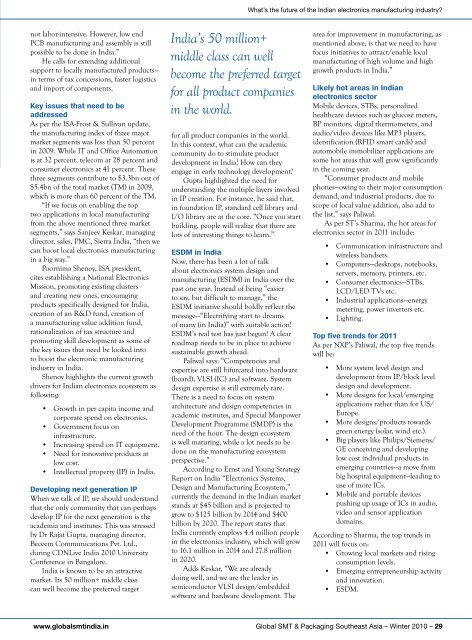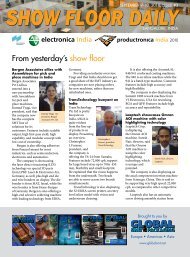South East Asia - WordPress.com - BluOcean.AdMedia
South East Asia - WordPress.com - BluOcean.AdMedia
South East Asia - WordPress.com - BluOcean.AdMedia
Create successful ePaper yourself
Turn your PDF publications into a flip-book with our unique Google optimized e-Paper software.
not labor-intensive. However, low end<br />
PCB manufacturing and assembly is still<br />
possible to be done in India.”<br />
He calls for extending additional<br />
support to locally manufactured products—<br />
in terms of tax concessions, faster logistics<br />
and import of <strong>com</strong>ponents.<br />
Key issues that need to be<br />
addressed<br />
As per the ISA-Frost & Sullivan update,<br />
the manufacturing index of three major<br />
market segments was less than 50 percent<br />
in 2009. While IT and Office Automation<br />
is at 32 percent, tele<strong>com</strong> at 28 percent and<br />
consumer electronics at 41 percent. These<br />
three segments contribute to $3.3bn out of<br />
$5.4bn of the total market (TM) in 2009,<br />
which is more than 60 percent of the TM.<br />
“If we focus on enabling the top<br />
two applications in local manufacturing<br />
from the above mentioned three market<br />
segments,” says Sanjeev Keskar, managing<br />
director, sales, PMC, Sierra India, “then we<br />
can boost local electronics manufacturing<br />
in a big way.”<br />
Poornima Shenoy, ISA president,<br />
cites establishing a National Electronics<br />
Mission, promoting existing clusters<br />
and creating new ones, encouraging<br />
products specifically designed for India,<br />
creation of an R&D fund, creation of<br />
a manufacturing value addition fund,<br />
rationalization of tax structure and<br />
promoting skill development as some of<br />
the key issues that need be looked into<br />
to boost the electronic manufacturing<br />
industry in India.<br />
Shenoy highlights the current growth<br />
drivers for Indian electronics ecosystem as<br />
following:<br />
• Growth in per capita in<strong>com</strong>e and<br />
corporate spend on electronics.<br />
• Government focus on<br />
infrastructure.<br />
• Increasing spend on IT equipment.<br />
• Need for innovative products at<br />
low cost.<br />
• Intellectual property (IP) in India.<br />
Developing next generation Ip<br />
When we talk of IP, we should understand<br />
that the only <strong>com</strong>munity that can perhaps<br />
develop IP for the next generation is the<br />
academia and institutes. This was stressed<br />
by Dr Rajat Gupta, managing director,<br />
Beceem Communications Pvt. Ltd.,<br />
during CDNLive India 2010 University<br />
Conference in Bangalore.<br />
India is known to be an attractive<br />
market. Its 50 million+ middle class<br />
can well be<strong>com</strong>e the preferred target<br />
www.globalsmtindia.in<br />
India’s 50 million+<br />
middle class can well<br />
be<strong>com</strong>e the preferred target<br />
for all product <strong>com</strong>panies<br />
in the world.<br />
for all product <strong>com</strong>panies in the world.<br />
In this context, what can the academic<br />
<strong>com</strong>munity do to stimulate product<br />
development in India? How can they<br />
engage in early technology development?<br />
Gupta highlighted the need for<br />
understanding the multiple layers involved<br />
in IP creation. For instance, he said that,<br />
in foundation IP, standard cell library and<br />
I/O library are at the core. “Once you start<br />
building, people will realize that there are<br />
lots of interesting things to learn.”<br />
esDM in India<br />
Now, there has been a lot of talk<br />
about electronics system design and<br />
manufacturing (ESDM) in India over the<br />
past one year. Instead of being “easier<br />
to say, but difficult to manage,” the<br />
ESDM initiative should boldly reflect the<br />
message—“Electrifying start to dreams<br />
of many (in India)” with suitable action!<br />
ESDM’s real test has just begun! A clear<br />
roadmap needs to be in place to achieve<br />
sustainable growth ahead.<br />
Paliwal says: “Competencies and<br />
expertise are still bifurcated into hardware<br />
(board), VLSI (IC) and software. System<br />
design expertise is still extremely rare.<br />
There is a need to focus on system<br />
architecture and design <strong>com</strong>petencies in<br />
academic institutes, and Special Manpower<br />
Development Programme (SMDP) is the<br />
need of the hour. The design ecosystem<br />
is well maturing, while a lot needs to be<br />
done on the manufacturing ecosystem<br />
perspective.”<br />
According to Ernst and Young Strategy<br />
Report on India “Electronics Systems,<br />
Design and Manufacturing Ecosystem,”<br />
currently the demand in the Indian market<br />
stands at $45 billion and is projected to<br />
grow to $125 billion by 2014 and $400<br />
billion by 2020. The report states that<br />
India currently employs 4.4 million people<br />
in the electronics industry, which will grow<br />
to 16.1 million in 2014 and 27.8 million<br />
in 2020.<br />
Adds Keskar, “We are already<br />
doing well, and we are the leader in<br />
semiconductor VLSI design/embedded<br />
software and hardware development. The<br />
What’s the future of the Indian electronics manufacturing industry?<br />
area for improvement in manufacturing, as<br />
mentioned above, is that we need to have<br />
focus initiatives to attract/enable local<br />
manufacturing of high volume and high<br />
growth products in India.”<br />
likely hot areas in Indian<br />
electronics sector<br />
Mobile devices, STBs, personalized<br />
healthcare devices such as glucose meters,<br />
BP monitors, digital thermometers, and<br />
audio/video devices like MP3 players,<br />
identification (RFID smart cards) and<br />
automobile immobilizer applications are<br />
some hot areas that will grow significantly<br />
in the <strong>com</strong>ing year.<br />
“Consumer products and mobile<br />
phones—owing to their major consumption<br />
demand, and industrial products, due to<br />
scope of local value addition, also add to<br />
the list,” says Paliwal.<br />
As per ST’s Sharma, the hot areas for<br />
electronics sector in 2011 include:<br />
• Communication infrastructure and<br />
wireless handsets.<br />
• Computers—desktops, notebooks,<br />
servers, memory, printers, etc.<br />
• Consumer electronics—STBs,<br />
LCD/LED TVs etc.<br />
• Industrial applications—energy<br />
metering, power inverters etc.<br />
• Lighting.<br />
Top five trends for 2011<br />
As per NXP’s Paliwal, the top five trends<br />
will be:<br />
• More system level design and<br />
development from IP/block level<br />
design and development.<br />
• More designs for local/emerging<br />
applications rather than for US/<br />
Europe.<br />
• More designs/products towards<br />
green energy (solar, wind etc.).<br />
• Big players like Philips/Siemens/<br />
GE conceiving and developing<br />
low cost individual products in<br />
emerging countries—a move from<br />
big hospital equipment—leading to<br />
use of more ICs.<br />
• Mobile and portable devices<br />
pushing up usage of ICs in audio,<br />
video and sensor application<br />
domains.<br />
According to Sharma, the top trends in<br />
2011 will focus on:<br />
• Growing local markets and rising<br />
consumption levels.<br />
• Emerging entrepreneurship activity<br />
and innovation.<br />
• ESDM.<br />
Global SMT & Packaging <strong>South</strong>east <strong>Asia</strong> – Winter 2010 – 29









